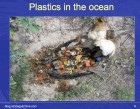The article Arctic ice melt an ‘economic time bomb’, 26 July 2013 – The Guardian – is one of the telling indicators.
Scientists say rapid melting of summer sea ice in the Arctic may release a “pulse” of methane, with dire implications for the global economy. See the full text:
http://www.scmp.com/news/world/article/1290611/arctic-ice-melt-economic-time-bomb#comment-30702
Says the article:
“ … the release of a single giant “pulse” of methane from thawing Arctic permafrost beneath the East Siberian sea “could come with a US$60 trillion global price tag”, according to the researchers who have for the first time quantified the effects on the global economy. Even the slow emission of a much smaller proportion of the vast quantities of methane locked up in the Arctic permafrost and offshore waters could trigger catastrophic climate change and “steep” economic losses, according to the study published in the journal Nature. The Arctic sea ice, which largely melts and reforms each year, is declining at an unprecedented rate. In 2013, it collapsed to under 3.5 million square kilometres by mid September, just 40 per cent of its usual extent in the 1970s. Because the ice is also losing its thickness, some scientists expect the Arctic to be largely free of summer ice by 2020.”
In my book Toxic Capitalism, published last year, this issue was already mentioned as one of the major threats to our climate. This is just a confirmation.
Another impact mentioned in my book comes out again: see what is happening in places like Switzerland. Still, people, blinded by ignorance, refuse to admit what is going on.
See: Grindelwald Journal – As Glaciers Melt, Alpine Mountains Lose Their Glue, Threatening Swiss Village, article by Jogn Tagliabue, New York Times, published: 29 May 2013:
http://www.nytimes.com/2013/05/30/world/europe/in-swiss-alps-glacial-melting-unglues-mountains.html?_r=0
Mountaineers are witness to the changes and fear the consequences when climbing.
My Books
CFL in China: the good and bad
Compact Fluorescent Light Bulbs (CFLs) can help you save money, use less energy, reduce light bulb changes, and lower greenhouse gas emissions, which lead to climate change.
In China they have become very popular and now the old type light bulbs are disappearing at a fast pace.
However we face here a serious problem, the same as for the batteries, printer and copier cartridges: there is virually nothing in place for safe recycling. Most people simply put it all in the trash with considerable dangers for the environment.
Worse, in case a CFP breaks do expect our Chinese friends (especially the maids) to do everything they should NOT do. Reason: mercury poisoning. One more item on the list of ignorance here. What is the government doing about it? Nothing.
Ever seen a collection point in supermarkets for used batteries and CFL? Obviously never I guess.
Read more:
http://www2.epa.gov/cfl
http://worldtruth.tv/understanding-the-dangers-of-fluorescent-light-bulbs/
Being green and protecting the environment is often done in the wrong way – CFLs and electric bikes are some of the (bad) examples. This is also mentioned in my book Toxic Capitalism.
Man Invents Machine To Convert Plastic Into Oil
As discussed in my book, we waste tons of plastics that pollute our soil, the rivers, lakes and oceans. The problem is that those plastics now enter the food chain (enjoy your fish!) but also use oil. See here two slides of my book presentation, talking about plastics in a dead albatross and more.
But some people show the way – there are solutions, not only to waste less but to recycle.
In an efficient and safe effort to save us from the ill-effects of plastic waste, Akinori Ito has developed a machine which converts plastic back into oil.
See the clip in Japanese with English subtitles.
http://www.flixxy.com/convert-plastic-to-oil.htm
The machine produced in various sizes, for both industrial and home uses, can easily transform a kilogram of plastic waste into a liter of oil, using about 1 kWh of electricity but without emitting CO2 in the process. The machine uses a temperature controlling electric heater instead of flames, processing anything from polyethylene or polystyrene to polypropylene (numbers 2-4). Comment: 1 kg of plastic produces one liter of oil, which costs $1.50. This process uses only about 1 kWh of electricity, which costs less than 20 cents! (as mentioned on flixxy)
Talking to Rutgers!
Today I talked to 24 MBA students from Rutgers Business School, The State University of New Jersey, at Novotel Peace in Beijing. The usual 90 minutes, with lively interaction from the students. Organized by ISP, with Denisa running the visits and seminars.
Group leaders from Rutgers: Prof. Chao C. Chen, Management and Global Business and Mr. Vincent Ogutu. Both received a copy of my book.
Are electric cars green? Some disagree
See the article “Don’t kid yourself that electric taxis are green” by Tom Holland in SCMP:
http://www.scmp.com/business/article/1238505/dont-kid-yourself-electric-taxis-are-green
I do not fully agree with Tom Holland but he does raise some valid points. We need indeed to look at the global ecological footprint. But saying no to e-vehicles is wrong. Their technology needs to improve and most important is to tackle the batteries. In the case of e-bikes in China, those are actually not green at all, because of the lead acid batteries. Lithium batteries are also still needing a better approach. As for the energy mix and the promotion of e-vehicles, read “Toxic Capitalism”: contrary to what most believe China is making serious efforts to increase the use of non-coal/oil based power stations, with renewable energy, natural gas, nuclear, etc. (leaving aside the issue of nuclear here). Trying to demonstrate a diesel or gasoline car is better is like trying to say, wind turbines and solar are bad. I personally and officially recommended the use of e-vehicles for the city of Beijing in the 12th Five Year Plan; the recommendation followed, except for some further incentives I had listed.




